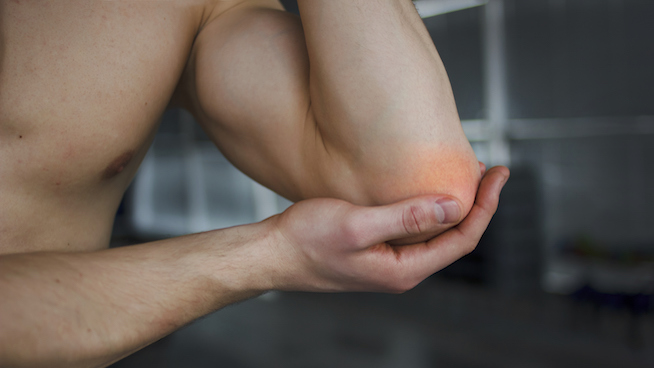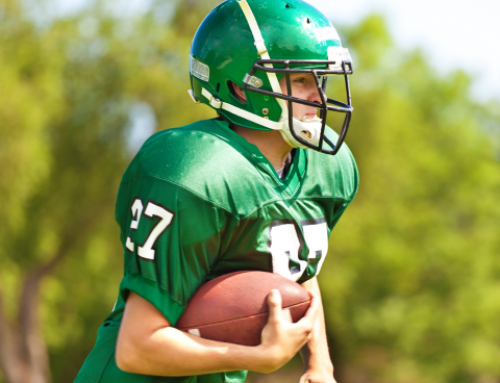Prevent These 4 Common Sports Injuries
![]()
Too often athletes, coaches, trainers and parents improperly manage injuries. They look at the site of the pain and assume the injury is located in that area, when the injury could have originated somewhere else in the kinetic chain.
Here are four common injuries that are often mismanaged, and some strategies to better treat them.
1. Calf Strains
It makes sense that calf strains are all too common. When you consider that athletes withstand 3 to 5 times their body weight upon impact in athletic movements such as sprinting and jumping exercise variations, you begin to understand the amount of physical stress placed on their calves and ankles. These areas are obviously the first to come into contact with the training surface, and they begin the force absorption process. Moreover, relative to the superior areas of the quads and hips, the calves are naturally much smaller structures of anatomy, putting them at even more of a functional disadvantage. As a result, the calves and ankles have to be extremely strong to counteract and handle the heavy workload of sport and competition and the extremely high number of foot contacts that are performed on a regular basis.
RELATED: Calf Exercises That Work
There is more to the story, though. If there is any weakness at the knee or hip, the calf and ankle have to work even harder through eccentric overload, which increases the risk of injury.
The only solution is to dose your athletes with a steady diet of bilateral and unilateral Squat and Deadlift variations, along with plenty of assistance or supplemental work for the hips and quads, to effectively support the calves and prevent future injury over the long term.
2. Ankle Sprains
Like calf strains, ankle sprains can be a result of proximal weakness, specifically at the posterior and lateral aspects of the hip. Hip abductor weakness is often associated with an increased risk for ankle sprain. There are several other movement scenarios where muscles located proximally at the hip would have to fire strong to help keep the foot in a healthy alignment. Immobilization strategies such as braces and taping can help in the interim and prevent further trauma to the ligaments as they heal, but if you don’t address weaknesses higher up in the body, the risk of re-injury is much higher, to say the least.
RELATED: What Is My Ankle Sprain Recovery Time?
3. Rack Wrist Pain

The rack is the synergistic support position of the hands, elbows and shoulders in a Front Squat hold or Olympic lift finish. The normal cue that I see most coaches and trainers expressing to their athletes when they are unable to obtain the proper rack position is to tell them to stretch their wrist flexors and triceps and come back and try again.
Unfortunately, not everything is flexibility-related, especially in the case of optimal racking technique. What I notice in nearly every athlete who struggles with front squatting and Olympic lifting and who reports pain in his wrists is simply lack of strength in the anterior shoulders. This would naturally de-load and remove stress to the wrists, since the resistance wouldn’t be sagging any more and causing the wrist to hyperextend.
RELATED: 4 Common Causes of Wrist Pain, and How to Fix Them
This is not to say that other weaknesses—specifically at the core, hips, and back—do not exist. It’s just that the shoulders are generally always weak as well. You can stretch any area you want, but until you build a solid base of strength in lifts like the Military Press, Bench Press, Push-Up variations, etc., you will not be able to isometrically support the bar in the rack position in any prescribed exercise without suffering wrist pain at some point—and your technique and lifting performance will inevitably suffer.
4. Tennis Elbow

Tennis elbow, or lateral epicondylitis, is inflammation to the outer part of the elbow joint, due in most cases to repetitive overuse. A lot of connective tissue flows through this area, and constant repetition can cause irritation and stress through increased friction.
In some of the literature, weaknesses in the upper back and thoracic spine have been linked to tennis elbow. You need to make sure you are developing these areas through plenty of t-spine mobility drills, pec/lat stretching, scap, chin-pulls and rowing work.
Logically, when an object is placed in the hands, the postural muscles of the upper and mid-back need to activate to support the distal areas at the elbow and wrist. This relationship is reciprocal, and grip training can stimulate the back and shoulders through a process known as “irradiation.” However, when an elbow injury is present, grip work should be limited.
Once the inflammation is minimal, progressive grip training can and should be resumed. In the meantime, more posterior upper-body training should be practiced using wrist straps, since most of these exercises still require you to grip the bar. There are other modifications you can make, but straps work great during the rehab phase. Many athletes suffer from chronic CNS fatigue, and the straps may also freshen them up a bit, since a few highly credible authorities have said that too much grip work is associated with potentially higher levels of nervous system drain.
References:
- Friel, K. “Ipsilateral hip abductor weakness after inversion ankle sprain.” J Athl Train, 41: 74-78, 2006.
- Beckman, SM. “Ankle inversion injury and hypermobility: effect on hip and ankle muscle electromyography onset latency.” Arch Phys Med Rehabil, 76: 1138-1143, 1995.
RECOMMENDED FOR YOU
Prevent These 4 Common Sports Injuries
![]()
Too often athletes, coaches, trainers and parents improperly manage injuries. They look at the site of the pain and assume the injury is located in that area, when the injury could have originated somewhere else in the kinetic chain.
Here are four common injuries that are often mismanaged, and some strategies to better treat them.
1. Calf Strains
It makes sense that calf strains are all too common. When you consider that athletes withstand 3 to 5 times their body weight upon impact in athletic movements such as sprinting and jumping exercise variations, you begin to understand the amount of physical stress placed on their calves and ankles. These areas are obviously the first to come into contact with the training surface, and they begin the force absorption process. Moreover, relative to the superior areas of the quads and hips, the calves are naturally much smaller structures of anatomy, putting them at even more of a functional disadvantage. As a result, the calves and ankles have to be extremely strong to counteract and handle the heavy workload of sport and competition and the extremely high number of foot contacts that are performed on a regular basis.
RELATED: Calf Exercises That Work
There is more to the story, though. If there is any weakness at the knee or hip, the calf and ankle have to work even harder through eccentric overload, which increases the risk of injury.
The only solution is to dose your athletes with a steady diet of bilateral and unilateral Squat and Deadlift variations, along with plenty of assistance or supplemental work for the hips and quads, to effectively support the calves and prevent future injury over the long term.
2. Ankle Sprains
Like calf strains, ankle sprains can be a result of proximal weakness, specifically at the posterior and lateral aspects of the hip. Hip abductor weakness is often associated with an increased risk for ankle sprain. There are several other movement scenarios where muscles located proximally at the hip would have to fire strong to help keep the foot in a healthy alignment. Immobilization strategies such as braces and taping can help in the interim and prevent further trauma to the ligaments as they heal, but if you don’t address weaknesses higher up in the body, the risk of re-injury is much higher, to say the least.
RELATED: What Is My Ankle Sprain Recovery Time?
3. Rack Wrist Pain

The rack is the synergistic support position of the hands, elbows and shoulders in a Front Squat hold or Olympic lift finish. The normal cue that I see most coaches and trainers expressing to their athletes when they are unable to obtain the proper rack position is to tell them to stretch their wrist flexors and triceps and come back and try again.
Unfortunately, not everything is flexibility-related, especially in the case of optimal racking technique. What I notice in nearly every athlete who struggles with front squatting and Olympic lifting and who reports pain in his wrists is simply lack of strength in the anterior shoulders. This would naturally de-load and remove stress to the wrists, since the resistance wouldn’t be sagging any more and causing the wrist to hyperextend.
RELATED: 4 Common Causes of Wrist Pain, and How to Fix Them
This is not to say that other weaknesses—specifically at the core, hips, and back—do not exist. It’s just that the shoulders are generally always weak as well. You can stretch any area you want, but until you build a solid base of strength in lifts like the Military Press, Bench Press, Push-Up variations, etc., you will not be able to isometrically support the bar in the rack position in any prescribed exercise without suffering wrist pain at some point—and your technique and lifting performance will inevitably suffer.
4. Tennis Elbow

Tennis elbow, or lateral epicondylitis, is inflammation to the outer part of the elbow joint, due in most cases to repetitive overuse. A lot of connective tissue flows through this area, and constant repetition can cause irritation and stress through increased friction.
In some of the literature, weaknesses in the upper back and thoracic spine have been linked to tennis elbow. You need to make sure you are developing these areas through plenty of t-spine mobility drills, pec/lat stretching, scap, chin-pulls and rowing work.
Logically, when an object is placed in the hands, the postural muscles of the upper and mid-back need to activate to support the distal areas at the elbow and wrist. This relationship is reciprocal, and grip training can stimulate the back and shoulders through a process known as “irradiation.” However, when an elbow injury is present, grip work should be limited.
Once the inflammation is minimal, progressive grip training can and should be resumed. In the meantime, more posterior upper-body training should be practiced using wrist straps, since most of these exercises still require you to grip the bar. There are other modifications you can make, but straps work great during the rehab phase. Many athletes suffer from chronic CNS fatigue, and the straps may also freshen them up a bit, since a few highly credible authorities have said that too much grip work is associated with potentially higher levels of nervous system drain.
References:
- Friel, K. “Ipsilateral hip abductor weakness after inversion ankle sprain.” J Athl Train, 41: 74-78, 2006.
- Beckman, SM. “Ankle inversion injury and hypermobility: effect on hip and ankle muscle electromyography onset latency.” Arch Phys Med Rehabil, 76: 1138-1143, 1995.












